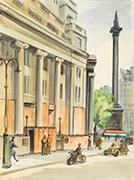Historian C. P. Stacey returns to Cockspur Street
April 9, 2015
The place was Canadian Military Headquarters (CMHQ), a warren of windowless rooms located on London’s Cockspur Street. As air raid sirens wailed and bombs fell outside, Colonel C. P. Stacey and the historians working for him painstakingly gathered the information needed to someday write the story of Canada’s army in the Second World War.
Now, nearly 75 years later, Colonel Stacey has returned to Cockspur Street. For the next year, visitors entering the revamped Canada House through the doors at 2-4 Cockspur Street will be greeted by History in the Making – C. P. Stacey and Canadian Military Headquarters, a display created by the Canadian War Museum in co-operation with the Canadian High Commission.
A demanding job
Stacey first stepped through the same doorway in December 1940. Built as the London office for Montreal’s Sun Life Assurance, the building had been gradually taken over as the Canadian Military Headquarters in the United Kingdom starting in late 1939.
A professionally trained historian who taught at Princeton before the war, Major Stacey, as he was then, had been sent to command the military history section of CMHQ. “His job,” says Jeff Noakes, Historian, Second World War at the Canadian War Museum, “was to collect information, interviews and documents, and prepare preliminary reports for the writing of the official history” — before the shooting ended.
A lasting legacy
Stacey’s work in London, says Noakes, profoundly affected his career — and the writing of Canadian military history. Remaining in the army after the war, Stacey oversaw the daunting and sometimes politically sensitive creation of the three-volume Official History of the Canadian Army in the Second World War, based on the material that he and his historians had so carefully collected in London and in the field. Stacey wrote two of the volumes himself. Even if historians disagree with his arguments or his conclusions, says Noakes, “his works remain fundamental ones that historians of the Canadian Army in the Second World War must address.” Stacey’s influence was felt in other ways, too. “Many of those who served under Stacey during the war went on to become notable military historians in their own right,” states Noakes. “He helped train a whole generation.” Retiring from the army in 1959, Stacey went on to teach at the University of Toronto.
As well as his uniform tunic, the display features photographs of Stacey, his colleagues in the historical section and pictures of London during the Blitz. One shot shows a deep crater from a bomb that Stacey described as falling outside CMHQ “just at its back door.” A guest book rediscovered during renovation at Canada House sits open to the page that Stacey signed in December 1940. A large reproduction of Jack Shadbolt’s 1945 watercolour of Canadian Military Headquarters provides a backdrop for the display on this remarkable historian.
A future relationship
Caroline Dromaguet, project manager for History in the Making – C. P. Stacey and Canadian Military Headquarters and the Canadian War Museum’s Manager of Exhibitions and Strategic Initiatives, says that both the Canadian Museum of History and the Canadian War Museum hope to continue working with Canada House on exhibits in the future.
Top: Canadian Military Headquarters, London, England, by George Tinning CWM 19710261-5424, Beaverbrook Collection of War Art © Canadian War Museum
Bottom: Colonel C. P. Stacey, Library and Archives Canada PA-501024
